The Nexus 7 (2013) Review
by Anand Lal Shimpi on August 22, 2013 6:00 PM ESTCPU Performance
The while the original Nexus 7 was fast for the money, the new Nexus 7 is just fast. Moving away from NVIDIA to Qualcomm, ASUS and Google settled on the APQ8064 Pro. Although we originally assumed this would be a quad-core Krait 200 based SoC, Brian's teardown revealed the part number 8064-1AA. What's special about that part number is it implies newer Krait 300 cores, making the SoC effectively a Snapdragon 600.
The CPU cores can run at up to 1.5GHz, putting it a bit lower than what we've seen from Snapdragon 600 based phones (e.g. HTC One tops out at 1.7GHz, while the US SGS4 hits 1.9GHz).
I was curious as to the impact of the lower frequency when combined with the potentially higher chassis TDP so I compared the Nexus 7 to the US Galaxy S 4. I turned to Geekbench because it offers a nicely woven mixture of single and multithreaded benchmarks, letting me look at peak available single core performance as well as what happens when multiple cores are active and working.
In this first graph we're looking at the first Krait 300 core running the workload. I've zoomed in to a small portion of the benchmark so we can get a better idea of CPU behavior:
The Nexus 7's CPU0 is almost always pegged at 1.5GHz whereas we see a lot of bursty thermal management on the smaller SGS4. This isn't unexpected, but what ends up happening is the sustained performance advantage drops from a peak theoretical max of 26% down to a more reasonable average gain of ~8%.
I was curious to see if multithreaded workloads showed any different behavior. Here we're looking at the fourth CPU core (CPU3). Note that it's not always active, which is why you see parts of the graph drop down to 0KHz. Once again we see similarly static behavior from the Nexus 7. Even with all four cores active, when you need the performance the Nexus 7 delivers a full 1.5GHz. These tests are short enough where we don't see tremendous swings in frequency, but once again we do see some frequency modulation in a smaller chassis.
The end result is that the Nexus 7's 1.5GHz Krait 300 cores are slower than what you'd get in a Galaxy S 4, however the gap isn't nearly as large as you'd expect it to be thanks to the larger chassis and how the platform is tuned. The Nexus 7 can run at 1.5GHz more consistently than Snapdragon 600 based phones can run at 1.7/1.9GHz.
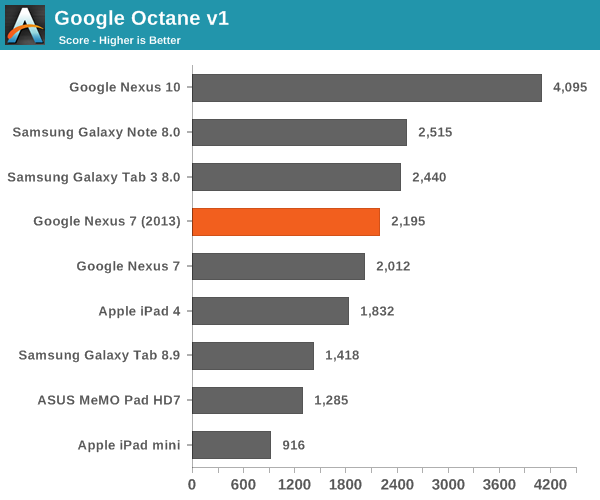


The GPU
Qualcomm seems to be frequency binning here, which is standard industry practice. Using binning to create these different SKUs gives Qualcomm pricing flexibility and also gives it the option to give large customers special treatment.
On the graphics side Qualcomm's Adreno 320 GPU makes an appearance. Clock speeds are also limited to 400MHz, compared to 450MHz for the high-end Snapdragon 600 implementations we've seen.
The APQ8064-1AA's dual-channel memory controller is populated with four x 16-bit DDR3L-1600 memory devices, giving the Nexus 7 a healthy amount of memory bandwidth. Peak memory bandwidth available to the APQ8064-1AA is 12.8GB/s, equalling what's available to Apple's A5X in the 3rd generation iPad with Retina display. Tons of memory bandwidth is obviously a pre-requisite for driving a high resolution display, and the combination of DDR3L-1600 and the Adreno 320 GPU delivers a butter smooth UI in all well written Android apps.
Although CPU performance is somewhat middle of the road compared to the rest of the landscape, GPU performance is faster than any other Nexus device on the market - and pretty much faster than any other similarly sized tablet:
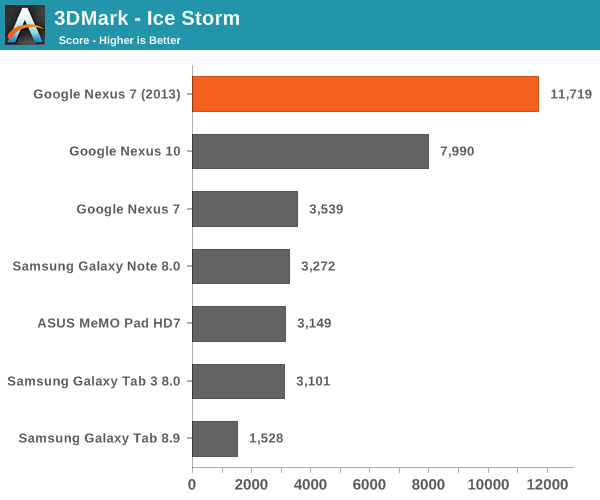
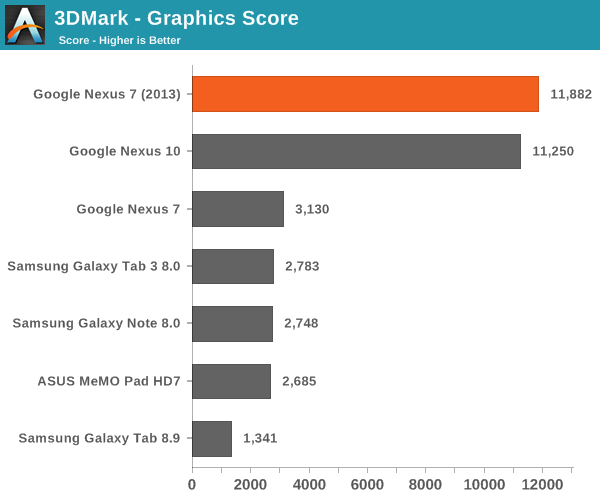
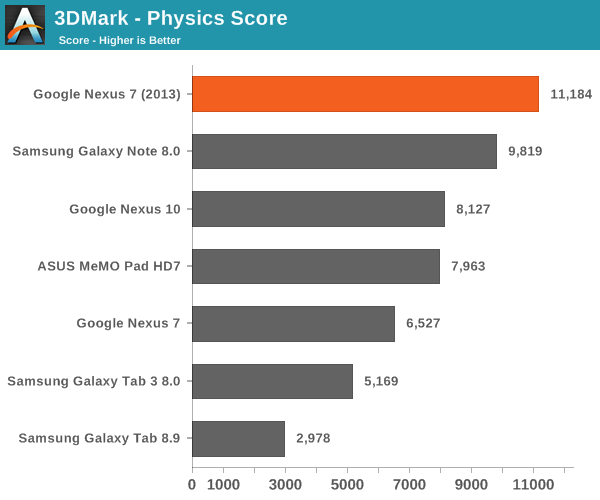
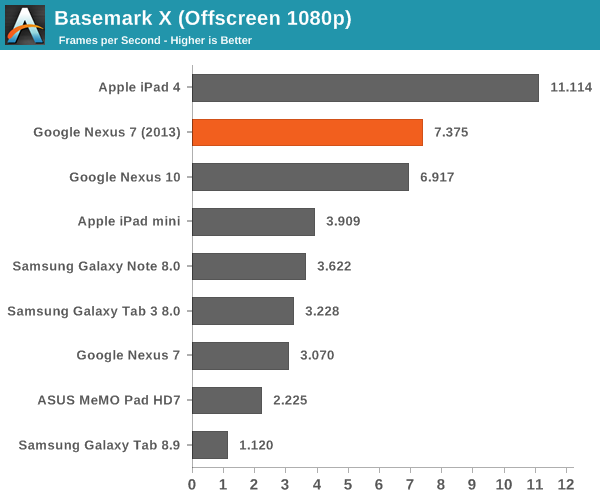
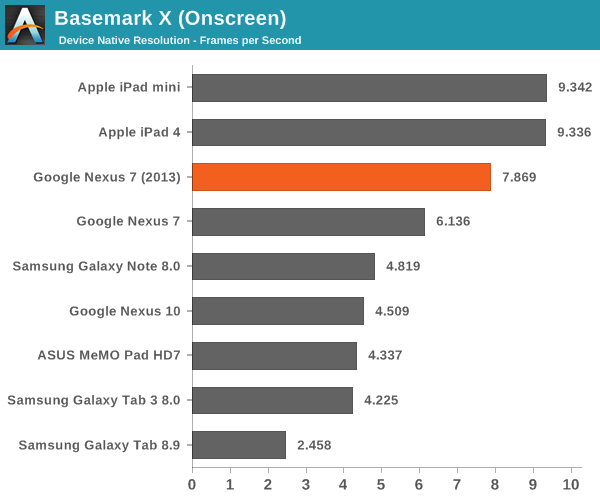
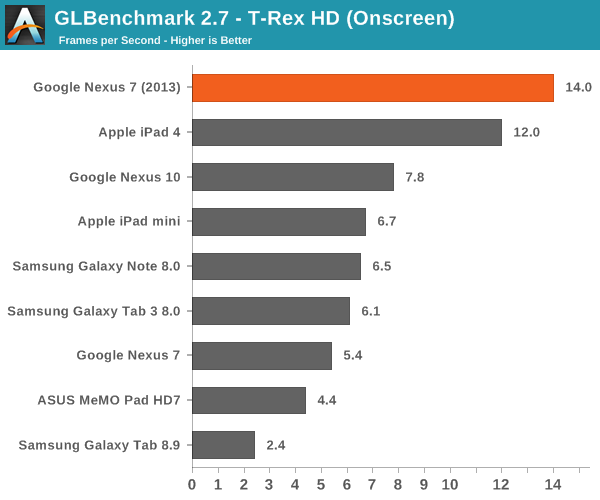
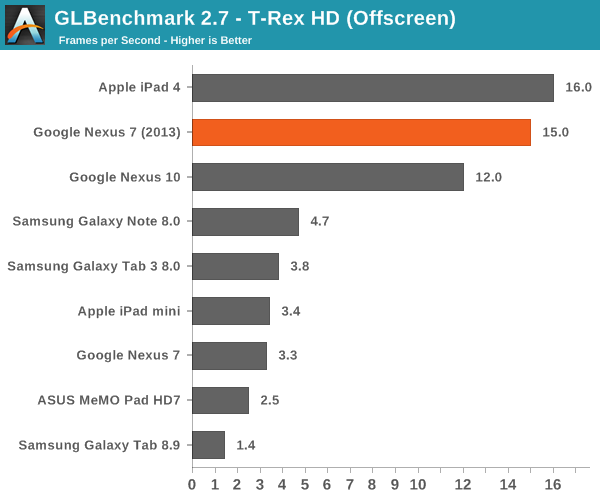
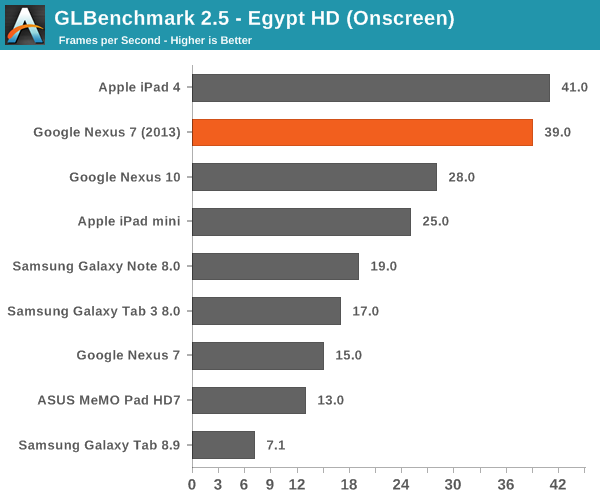
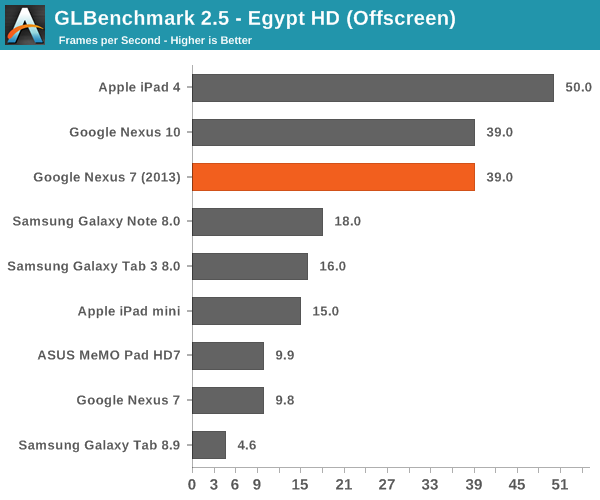
I played Modern Combat 4 as well as Shadowgun, both demanding 3D titles, on the new Nexus 7. Both titles appeared to render at the Nexus 7's native 1920 x 1200 resolution, and both appeared to do so at around 30 fps.


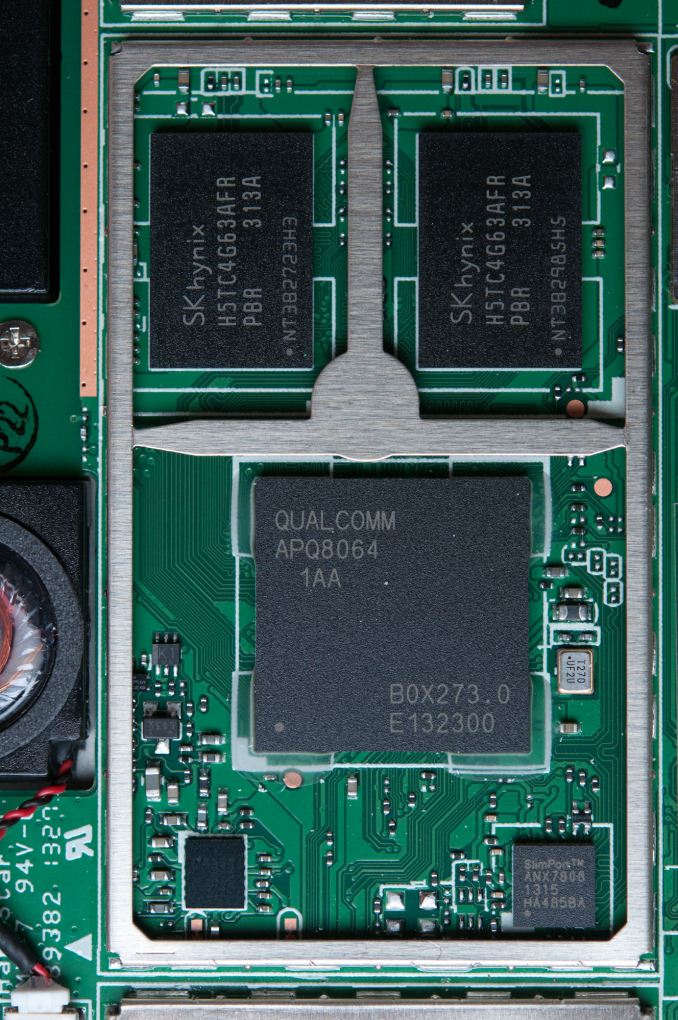
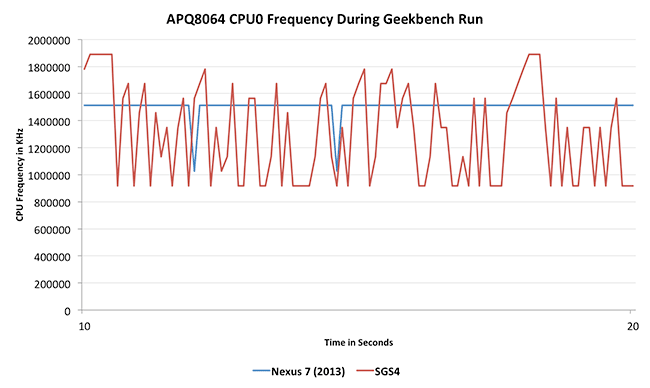
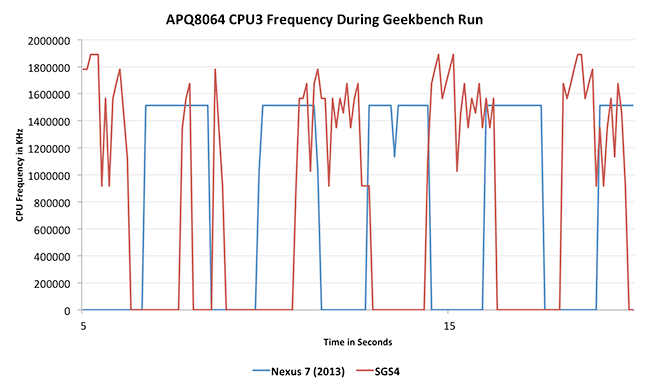








202 Comments
View All Comments
darwinosx - Thursday, August 22, 2013 - link
I'll review it. It's a piece of junk with poor quality build, a washed out screen, and a really slow gpu. The iPad 4 blows the doors off it. Hows that?smartypnt4 - Thursday, August 22, 2013 - link
You're an incredibly negative individual, do you know that? Everyone knows the iPad 4 is better than the N10. That's never really been a debate. The N10 also costs $100 less, so there's that.I agree with your essential assessment, though. In essence, it had build quality issues, and a dreadful screen in comparison to the N7 and the iPad 3/4. Colors were washed out, it was incredibly dim, lacked contrast, etc. The really slow GPU thing I can't really attest to, although benchmarks indicate it's not *horribly* slow, especially for something that came out last year. Yes, it's slower than the iPad 4. Basically, anything released within ~6 months of an iPad historically can't match the GPU power. Comparing it to the Android space, it was relatively quick last year. Not so much now, though.
I do agree with you, though. Proof: when my N10 was stolen, I replaced it with an iPad 4.
Midwayman - Friday, August 23, 2013 - link
Anything from 2012 with a full HD screen or higher running Android was underspec'd anyways. They hadn't upped the hardware to deal with the demands of the higher res screens yet. 2013 is looking to be a different matter.smartypnt4 - Sunday, August 25, 2013 - link
After owning and using the N10 at launch last year, I can say that I never felt that the GPU held it back in the OS. The transitions were all very smooth throughout the OS. Some apps behaved weirdly, but that was because they rendered to a fixed size, which looks comical on a tablet with a pixel density that high. There were plenty of other things that were off about the N10, though. Supposedly ASUS got the nod for this year's Nexus 10, so I'm looking forward to their take on it.jl0329 - Wednesday, October 9, 2013 - link
Go home, time to change your diaper you little brat.Krysto - Thursday, August 22, 2013 - link
I agree they should move to 8" next year, or at least 7.7", and no more than a width of five inches, because then it becomes too wide (the iPad Mini is too wide for one-hand use).But yeah I'd prefer it was a bit bigger to justify getting one when you already have a big smartphone.
sherlockwing - Thursday, August 22, 2013 - link
Don't know about you, but I bought a N7 2013 when I already have a GS4(5") and the Media viewing expewrience on the Nexus 7 is substantially better. The N7's display(22.02 in^2) is twice as large as GS4's(10.68 in^2), and 85% more space when viewing 16:9 content( 19.8 vs 10.68). I find it perfectly justifiable to buy even if I have a GS4.Now if your defination for "big smartphone" is a Note then I see your point. It won't take too much effort to get a 7.5" screen on N7 if the bezel is reduced to Ipad Mini level. The screen/front area ratio of N7 is only 62%, Ipad mini's is 71.8%.
CSMR - Thursday, August 22, 2013 - link
"802.11ac is probably the only thing missing from this otherwise awesome platform"802.11ac will take years to start being used, and decades before it makes earlier wifi standards obsolete. In the life of a current device, there will be no occasions when 802.11ac will be available and providing internet but other wifi standards are not.
Lack of cellular connectivity on the other hand results in lack of internet access in most locations, and is a major omission.
solipsism - Thursday, August 22, 2013 - link
If you're defining it as not being used anywhere by anyone in favour of a new standard, then I guess I agree it will take decades. But by that notion there are people still using floppy disks.If you wish to be less draconian with your definition then your decades claim doesn't hold water. Including 802.11b in a device that supports 802.11g/n as a back up that is inexpensive for the component vendor to include doesn't mean it's being utilized extensively.
Also note is was only a decade between the 802.11b and n standards and 802.11n took off faster (for various reasons) than 802.11b so I can't see how it will be at least 2x longer before it gains a foothold, especially considering the focus society has for WiFi and excellent job the committee did in ratifying ac compared to n.
Finally, "there will be no occasions when 802.11ac will be available" and "802.11ac will take years to start being used" are just outright wrong. I use 802.11ac every single day. It's available! You can buy routers and devices that use this standard and they aren't priced at levels that make it unreasonable to obtain.
CSMR - Friday, August 23, 2013 - link
I was not saying it will take decades for people to start using 802.11ac. What will take decades is for them to switch off 802.11g and 802.11n. You may use 802.11ac now and good for you, but you can still get an internet connection with 802.11g/n. The main advertised advantage of 802.11ac is speed, but it will at least 10 years until typical internet connections saturate an 802.11g link let alone 802.11n.I am not against putting 802.11ac in devices as soon as it becomes a standard integrated part of modern chipsets, but the point is always-on internet is important, and if you do not have cellular connectivity then you will lack internet whenever you are outside your wifi network.